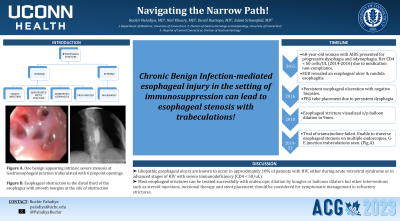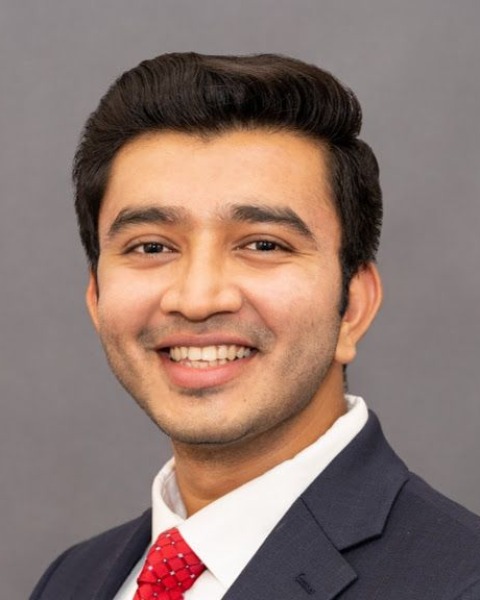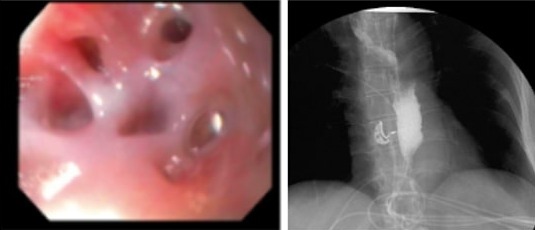Monday Poster Session
Category: Esophagus
P1912 - Navigating the Narrow Path: Chronic Benign, Severe Esophageal Strictures in a Patient With Acquired Immune Deficiency Syndrome
Monday, October 23, 2023
10:30 AM - 4:15 PM PT
Location: Exhibit Hall

Has Audio

Ruchir Paladiya, MBBS
UConn Health
Hartford, CT
Presenting Author(s)
Award: Presidential Poster Award
Ruchir Paladiya, MBBS1, Neil Khoury, MD2, David Restrepo, MD3, Adina Amin, MD4, Adam Schoenfeld, MD5
1UConn Health, Hartford, CT; 2UConn Health, West Hartford, CT; 3University of Connecticut, Farmington, CT; 4New York-Presbyterian Brooklyn Methodist Hospital, New York, NY; 5Hartford Hospital, Hartford, CT
Introduction: Esophageal stricture refers to an abnormal narrowing of the esophageal lumen. Intrinsic etiologies may include caustic ingestion, longstanding gastroesophageal reflux, untreated type 2 eosinophilic inflammation in eosinophilic esophagitis, or drug-induced injury. External compression from malignancy may also cause stricturing. We present a unique case of a patient with AIDS who developed chronic benign infection-mediated strictures unresponsive to dilation.
Case Description/Methods: A 68-year-old woman with AIDS presented to clinic for progressive dysphagia for over six years. She denied tobacco smoking, prior caustic ingestion, radiation exposure. She had not been taking Aspirin, NSAIDs, oral bisphosphonates or doxycycline. Her CD4 cell counts were < 50 cells/UL from at least 2014-2016. In 2015, she initially presented with odynophagia. EGD revealed esophageal ulcers, diffuse candida esophagitis treated with Fluconazole. In 2016, repeat EGD revealed esophageal ulceration, with negative biopsies. She had recurrence of candida esophagitis in 2017. Due to persistent dysphagia along with antiretroviral therapy medication non-compliance, the patient underwent PEG with feeding tube placement in 2016. In 2018, repeat EGD revealed a stricture at the GEJ, status post balloon dilation to 9mm. When the patient returned one month later, and again in 2019, the stricture was injected with 40 mg of Triamcinolone and could not be traversed. The stricture still could not be traversed seven months later. Repeat endoscopic image from 2019 and barium esophagram are reported below (Figures A-B). Biopsies were negative for fungal/viral pathogens, malignancy and dysplastic changes. In 2022, there was a new stricture in the upper third of the esophagus that was dilated by traversing the endoscope, however, the GEJ stricture could not be traversed. Patient was offered endoscopic stent placement and cardiothoracic surgery evaluation which she deferred.
Discussion: Idiopathic esophageal ulcers are known to occur in approximately 10% of patients with HIV, either during acute retroviral syndrome or in advanced stages of HIV with severe immunodeficiency (CD4 < 50/uL). The progression of stenosis to the point where trabeculations form in the esophagus is rare, especially in the setting of benign infection-mediated esophageal injury. Early diagnosis and treatment of esophageal strictures in patients with HIV/AIDS is important, as they can lead to significant morbidity if left untreated.

Disclosures:
Ruchir Paladiya, MBBS1, Neil Khoury, MD2, David Restrepo, MD3, Adina Amin, MD4, Adam Schoenfeld, MD5. P1912 - Navigating the Narrow Path: Chronic Benign, Severe Esophageal Strictures in a Patient With Acquired Immune Deficiency Syndrome, ACG 2023 Annual Scientific Meeting Abstracts. Vancouver, BC, Canada: American College of Gastroenterology.
Ruchir Paladiya, MBBS1, Neil Khoury, MD2, David Restrepo, MD3, Adina Amin, MD4, Adam Schoenfeld, MD5
1UConn Health, Hartford, CT; 2UConn Health, West Hartford, CT; 3University of Connecticut, Farmington, CT; 4New York-Presbyterian Brooklyn Methodist Hospital, New York, NY; 5Hartford Hospital, Hartford, CT
Introduction: Esophageal stricture refers to an abnormal narrowing of the esophageal lumen. Intrinsic etiologies may include caustic ingestion, longstanding gastroesophageal reflux, untreated type 2 eosinophilic inflammation in eosinophilic esophagitis, or drug-induced injury. External compression from malignancy may also cause stricturing. We present a unique case of a patient with AIDS who developed chronic benign infection-mediated strictures unresponsive to dilation.
Case Description/Methods: A 68-year-old woman with AIDS presented to clinic for progressive dysphagia for over six years. She denied tobacco smoking, prior caustic ingestion, radiation exposure. She had not been taking Aspirin, NSAIDs, oral bisphosphonates or doxycycline. Her CD4 cell counts were < 50 cells/UL from at least 2014-2016. In 2015, she initially presented with odynophagia. EGD revealed esophageal ulcers, diffuse candida esophagitis treated with Fluconazole. In 2016, repeat EGD revealed esophageal ulceration, with negative biopsies. She had recurrence of candida esophagitis in 2017. Due to persistent dysphagia along with antiretroviral therapy medication non-compliance, the patient underwent PEG with feeding tube placement in 2016. In 2018, repeat EGD revealed a stricture at the GEJ, status post balloon dilation to 9mm. When the patient returned one month later, and again in 2019, the stricture was injected with 40 mg of Triamcinolone and could not be traversed. The stricture still could not be traversed seven months later. Repeat endoscopic image from 2019 and barium esophagram are reported below (Figures A-B). Biopsies were negative for fungal/viral pathogens, malignancy and dysplastic changes. In 2022, there was a new stricture in the upper third of the esophagus that was dilated by traversing the endoscope, however, the GEJ stricture could not be traversed. Patient was offered endoscopic stent placement and cardiothoracic surgery evaluation which she deferred.
Discussion: Idiopathic esophageal ulcers are known to occur in approximately 10% of patients with HIV, either during acute retroviral syndrome or in advanced stages of HIV with severe immunodeficiency (CD4 < 50/uL). The progression of stenosis to the point where trabeculations form in the esophagus is rare, especially in the setting of benign infection-mediated esophageal injury. Early diagnosis and treatment of esophageal strictures in patients with HIV/AIDS is important, as they can lead to significant morbidity if left untreated.

Figure: Figure A. Endoscopic finding of one benign appearing intrinsic severe stenosis at Gastroesophageal junction trabeculated with 6 pinpoint openings.
Figure B. Barium esophagram showing severe obstruction in the distal third of the esophagus.
Figure B. Barium esophagram showing severe obstruction in the distal third of the esophagus.
Disclosures:
Ruchir Paladiya indicated no relevant financial relationships.
Neil Khoury indicated no relevant financial relationships.
David Restrepo indicated no relevant financial relationships.
Adina Amin indicated no relevant financial relationships.
Adam Schoenfeld indicated no relevant financial relationships.
Ruchir Paladiya, MBBS1, Neil Khoury, MD2, David Restrepo, MD3, Adina Amin, MD4, Adam Schoenfeld, MD5. P1912 - Navigating the Narrow Path: Chronic Benign, Severe Esophageal Strictures in a Patient With Acquired Immune Deficiency Syndrome, ACG 2023 Annual Scientific Meeting Abstracts. Vancouver, BC, Canada: American College of Gastroenterology.

